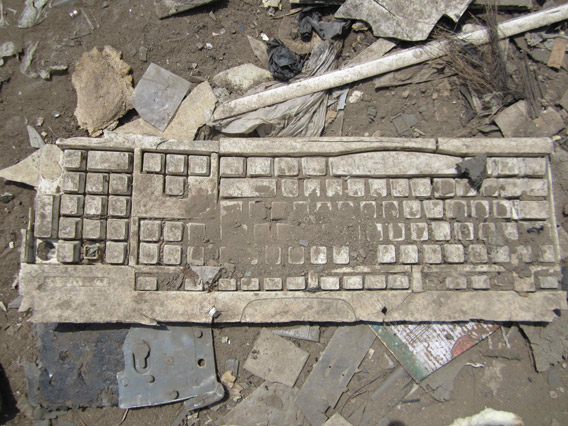
Keyboard finds its way to Agbogbloshie. Photo by: David Fedele.
Shirtless boys rapidly pull the computer apart, discarding bits and pieces, until they expose the wires, yank them out, and toss them into a fire. Acrid, toxic smoke blooms as the boys prod the wires and the fire strips the plastic around the wires, leaving the sought-after copper. Welcome, to Agbogbloshie, where your technology goes to die.
A new film e-wasteland captures the horrors of the world’s largest e-waste slum through surreal and staggering images. Shot over three weeks by one-man guerrilla filmmaker, David Fedele, e-wasteland is an entirely visual experience without dialogue or voice-over.
“I wanted to visually present a particular environment, attempt to show it as truthfully as possible, and give people the responsibility to think about the issues themselves,” Fedele told mongabay.com in an interview. “I believe that images can be far more powerful than words, and can have a much bigger impact and remain in your memory longer.”
A slum of Ghana’s capital city, Accra, Agbogbloshie is home to some 40,000 people, mostly migrants from rural areas, and many eke out a living by breaking down and burning e-waste for raw materials that can be re-sold. The slum is a byproduct of what Fedele calls the western world’s “obscene obsession […] with consuming, discarding, then consuming again.”
“I attempted to show that these expensive ‘things’ that we acquire, once they get old or broken, are nothing more than bits of plastic, metal, chemicals and other waste,” he explains. “That’s what struck me the more time I spent at Agbogbloshie. I saw a photocopier, but all they saw was copper, metal, computer boards … and a whole lot of plastic in the way stopping them from reaching these things! And it is ALL for money. The photocopier ONLY has value because its PARTS are valuable to someone. But as a photocopier, it is totally worthless.”
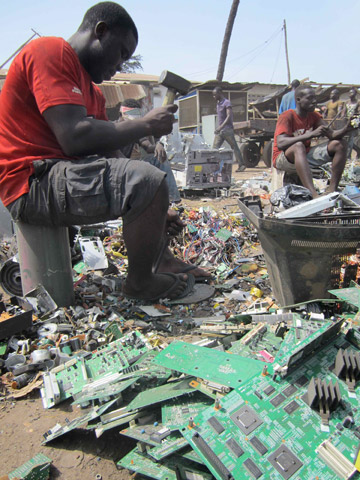 Sorting e-waste. Photo by: David Fedele. |
Once the waste is broken down, Fedele says raw materials are often exported back to the industrial world, “leaving behind illness and sickness, pollution, and environmental destruction [in Agbogbloshie].”
E-waste includes many toxic materials such as lead, arsenic, cadmium, and mercury. With no health or environmental protections in the slum, the toxins contaminate the air, water, and the food consumed in the slum.
“Filming was extremely difficult, as the conditions are appalling. The area is constantly covered in thick, toxic smoke from the burning of electrical cables that goes on all day and night,” Fedele says, noting that “Apart from the conditions, I was constantly challenged ethically and morally about the concept of filming in a slum and a dumpsite. Understandably, most people didn’t want me to film them, as they were ashamed of the work that they did, and the conditions they live in.” Everyone he spoke to told Fedele that the slum was ‘not suitable for human habitation.’ Locals have even dubbed the slum Sodom and Gomorrah, two cities that are destroyed by fire and sulfur in the Bible.
Still Fedele was adopted by a local troupe of e-waste boys.
“We would sit together, eat together and drink together. It is an extraordinary thing—these boys, who have virtually nothing, would invite me to share their food at every meal,” he says.
Fedele is by no means a luddite: “electronics are an important, necessary and growing part of today’s society, which we are all part of, including me. I sit here writing this on an Apple Mac, having shot a film with a digital video camera, and asking people to watch my film online.” However, he stresses that we must address the horrifying conditions in Agbogbloshie and that tech companies should take on a more active role in dealing with the problem.
“I believe that companies should be forced to take much more responsibility for their products once they reach the end of their lifetime, and make it easier for consumers to recycle their products locally. If a company is happy to ‘introduce’ a product into the world, they must be forced to take responsibility for this product, including its safe and environmentally sound disposal,” he says.
In a April 2012 interview David Fedele discusses his new film e-wasteland, including the conditions he found in Agbogbloshie, how people end up there, and what can be done.
AN INTERVIEW WITH DAVID FEDELE
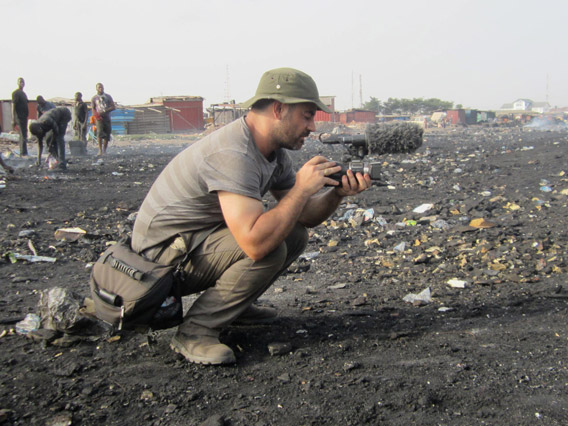
Fedele filming in Agbogbloshie. Photo by: David Fedele.
Mongabay: What drew you to Agbogbloshie?
David Fedele: I have been increasingly interested in thinking about waste in general, particularly in relation to our consumer society. This obscene obsession we have with consuming, discarding, then consuming again.
I started researching the concept of electronic waste disposal (e-waste), and discovered that it was a huge and growing problem in the world, particularly in developing countries. And this issue is increasing dramatically, in part due to the huge volume of second hand and condemned electronic goods that are exported every year from the “developed” world.
E-waste disposal is an issue that we all are a part of and contributing towards, however it is not widely known. I realized I wanted to make a film exploring e-waste, and my research led me to Agbogbloshie, Ghana, the largest e-waste dump site in Africa.
Mongabay: The film is practically a ‘silent film’, there is no dialogue but rather a visual experience of life in a slum where people garner a living by salvaging metals from e-waste. Why did you choose this method?
David Fedele: I had seen a number of journalistic documentaries that focused on the people working with e-waste, and portrayed them as victims, using poor interviews and voice-overs, and I was extremely conscious that I didn’t want to do this. I wanted to visually present a particular environment, attempt to show it as truthfully as possible, and give people the responsibility to think about the issues themselves.
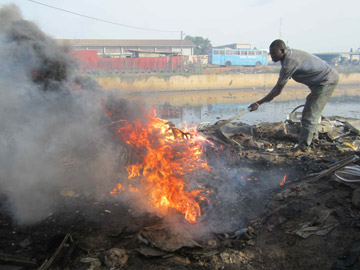 E-waste is burned to obtain raw materials, a process which is incredibly hazardous given the toxic fumes. Photo by: David Fedele. |
I believe that images can be far more powerful than words, and can have a much bigger impact and remain in your memory longer. I wanted to make a film about the e-waste, rather than the people that are involved in the work. I want people to contemplate where “things” end up at the end of their life. For me, that is what the film is about—where THINGS go at the end of their life—it is as much a film about “things” as about “people”.
For that reason, I wanted to show many visuals of things getting smashed and broken down. I attempted to show that these expensive “things” that we acquire, once they get old or broken, are nothing more than bits of plastic, metal, chemicals and other waste.
That’s what struck me the more time I spent at Agbogbloshie. I saw a photocopier, but all they saw was copper, metal, computer boards … and a whole lot of plastic in the way stopping them from reaching these things! And it is ALL for money. The photocopier ONLY has value because its PARTS are valuable to someone. But as a photocopier, it is totally worthless.
So I guess I am trying to subtly show some of my thoughts about our “consumer” society, and these “things” that we must have. But at the end of their life, they are nothing special at all—just a whole lot of PARTS.
But I was also wanting to show that these THINGS have their life in the “developed world”, come to Africa once they are junk to be broken back down into their “parts”, and then exported back to the developed world to continue making electronics for the developed world to use and benefit from—while leaving behind illness and sickness, pollution, and environmental destruction.
Mongabay: Some of the images in the film are almost surreal like something out of a Hollywood post-apocalyptic film. What was the experience like of filming in Agbogbloshie for months?
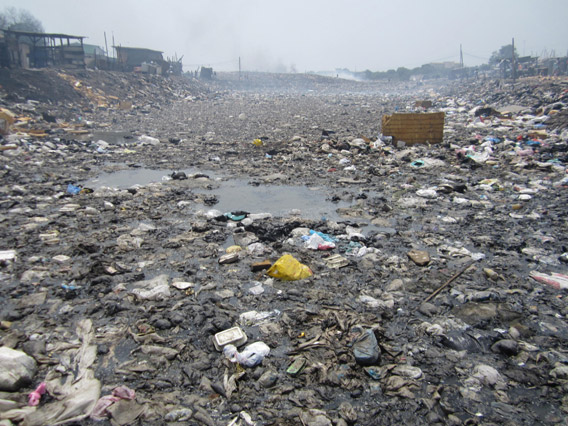
‘Without fail everyone that I spoke to that lived and worked at Agbogbloshie, agreed that the entire area is not suitable for human habitation.’ Photo by: David Fedele.
David Fedele: Filming was extremely difficult, as the conditions are appalling. The area is constantly covered in thick, toxic smoke from the burning of electrical cables that goes on all day and night. It was extremely hot and humid and physically and mentally challenging.
Apart from the conditions, I was constantly challenged ethically and morally about the concept of filming in a slum and a dumpsite. Understandably, most people didn’t want me to film them, as they were ashamed of the work that they did, and the conditions they live in. So I had to find a compromise between what I thought was important to show, while respecting the privacy of the people that work and live there.
Communication was extremely difficult as most of the people at Agbogbloshie speak very little English, if any. However I was very much embraced by the boys that allowed me to film them, and we would sit together, eat together and drink together. It is an extraordinary thing—these boys, who have virtually nothing, would invite me to share their food at every meal.
Mongabay: How does this e-waste end up in Ghana in the first place?
David Fedele: Very little of the electronics that end up at Agbogbloshie are actually produced in Ghana. Every year, over 200,000 tonnes (200 million kilograms) of electronic equipment arrives into the country, mainly from the developed world. They generally arrive in containers, transported by ship to the main port of Tema in Accra, the capital of Ghana.
The demand for electronic equipment is growing rapidly, due to an increasing connection to the global electronic world. Initially the concept of receiving second-hand electronics was embraced, as it “bridged the digital divide,” and allowed people that couldn’t afford brand new electronics the opportunity to access cheaper computers and other devices.
But most of the second-hand electronic goods that arrive in Ghana are old and nearing the end of their life, and generally within one to two years will be discarded as e-waste. There is no facility in Ghana to manage the disposal of e-waste in an environmentally sound manner, so inevitably most of it will end up at Agbogbloshie.
It is illegal to export/import e-waste, but Ghana has an unregulated and unrestricted import regime for second-hand electronic goods, so e-waste can enter the country under the guise of second-hand goods without restriction or detection.
Mongabay: Most of the people working in this trade are young men. Why?
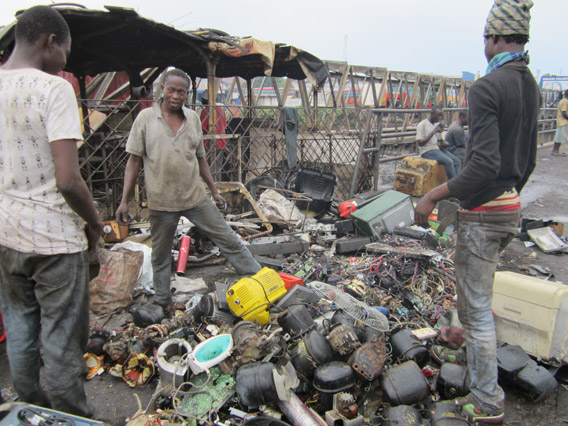
The hazardous trade is mostly undertaken by young migrant men with ‘nothing.’ Photo by: David Fedele.
David Fedele: Almost all of the people working in electronic scraps at Agbogbloshie are from the same language region in the North of Ghana. They are mainly boys and young men, generally uneducated and with few employable skills, and are drawn to the capital city, Accra, to try to “find money.”
A lot of these boys are sent by their family in the North, which is mainly a farming and agricultural area, to make money to send back to their family. Also a lot of the boys have only one or no parents alive, and are forced to make a living for themselves.
Most have family or friends living at the Agbogbloshie slum, so this is their first point of contact when they arrive. And the easiest way for them to try to make a little bit of money to put food in their stomach is to work salvaging and recycling the e-waste.
Women and girls don’t work in the electronic scrap yard, but make money by “supporting” the men and boys. They mainly sell food and water around the working areas and inside the slum.
Mongabay: Burning and dismantling e-waste can be incredibly dangerous as you note at the end of the film, releasing toxic metals and chemicals. Are the people involved in this trade aware of the health risks?
David Fedele: Generally the people involved in recycling e-waste at Agbogbloshie have absolutely no idea about any of the health risks involved.
When the people arrive at Agbogbloshie, they have NOTHING. They live on a day-by-day basis, and basically will do whatever is required to make a little bit of money, just to survive. The last thing they are concerned about is their health.
So the first thing is that they are not educated to be aware that this work is extremely dangerous and toxic. The second is that even if they are aware of this, they don’t really have a choice.
And as the health risks are not necessarily immediate, and can affect them over a long period of time, they are just dismissed as not being important, as the critical thing is to survive today, not to worry about tomorrow.
Mongabay: Were you ever concerned for your own health?
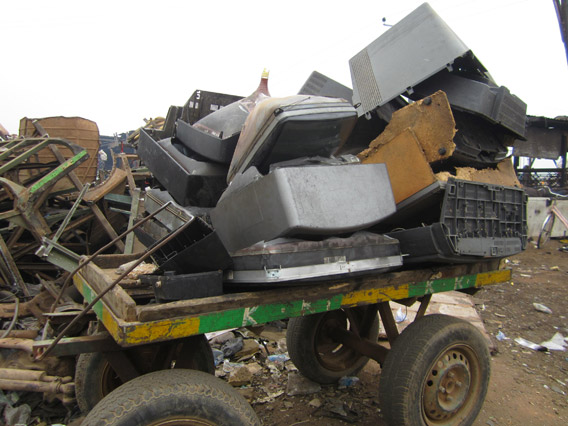
TVs and other consumer goods await dismemberment. Photo by: David Fedele.
David Fedele: That’s a good question…yes and no. It’s a strange thing when you decide to undertake a project such as this. You understand that there are inherent risks involved, but once you decide to actually go and make the film, you need to put these to the side a little bit.
I was constantly aware of the health risks. The primary area where I was filming was down-wind to the main burning site, and was almost permanently covered in toxic smoke. The smell is unimaginable, and even now when I watch the film, I can still smell the smoke.
I also totally underestimated what it would be like walking around and filming at a dumpsite. Without being too graphic, the entire area is basically an open toilet. I didn’t want to film too much of this as I didn’t feel it was relevant to my film, but without fail everyone that I spoke to that lived and worked at Agbogbloshie, agreed that the entire area is not suitable for human habitation.
I knew that the film I wanted to make was an observational film, rather than an investigative report. And to observe you must spend time. I guess you just try to find that fine line between making the best possible project that you can, and being concerned with your own health.
Mongabay: The film highlights a very pressing issue, but how do you find an audience for it? Especially one that isn’t aware of the issue?
David Fedele: Finding an audience that isn’t aware of the issues involved is actually quite easy, as I don’t believe that e-waste is a widely acknowledged and known issue. It is more difficult to actually reach this audience.
The full version of the film (20mins) is currently online on the film’s website: www.e-wastelandfilm.com.
The film will also be available world-wide through my distributor Ronin Films, who are mainly focused on the educational market, and are also distributing my previous film Bikpela Bagarap (Big Damage). [see interview on Fedele’s previous work: Big damage in Papua New Guinea: new film documents how industrial logging destroys lives.]
I will be submitting the film to all of the major environmental film festivals around the world, and the film will have its world premiere here in Accra, Ghana, at the middle of June—at the Environmental Film Festival of Accra. They have invited me to attend the festival to present the film and also talk about the issues involved. This is an amazing opportunity for the screen to be filmed at the place where it was produced and is the most relevant.
Though the film has only been recently completed, I have already been contacted by numerous groups, institutions and NGOs, that would like to use the film in their education and awareness work.
Mongabay: Given that this is a hugely complex problem, do you have any recommendations for solving it?
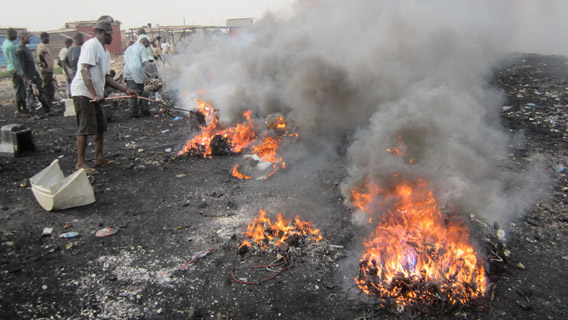
‘The smell is unimaginable, and even now when I watch the film, I can still smell the smoke.’ Photo by: David Fedele.
David Fedele: E-waste disposal and recycling is an extremely complex and complicated issue, without any easy solutions. However there are definitely things that can and should be done to minimize the environmental and human harm that currently exists.
Firstly, I believe that there must be much stricter rules and enforcement in stopping the direct importation of e-waste into developing countries, such as Ghana.
However even if this was stopped or reduced, there is still going to be a huge volume of e-waste generated from the legitimate importation of second-hand electronic goods, and locally generated e-waste.
In Ghana, there is no proper management or infrastructure in place for the environmentally sound disposal of e-waste. It is essential that the government acknowledges the huge and growing issue of e-waste, and addresses this to ensure that e-waste can be recycled in a responsible manner, both for the environment and the people involved in the recycling.
In a bigger global picture however, I believe that companies should be forced to take much more responsibility for their products once they reach the end of their lifetime, and make it easier for consumers to recycle their products locally. If a company is happy to “introduce” a product into the world, they must be forced to take responsibility for this product, including its safe and environmentally sound disposal.
Mongabay: Anything the average person can do to help?
David Fedele: It is essential that we understand and appreciate that we make decisions every day that directly or indirectly affect others elsew here on the planet.
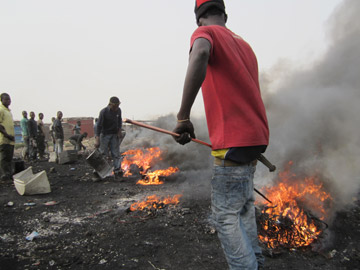 A young man stokes burning e-waste. Photo by: David Fedele. |
The reality is that electronics are an important, necessary and growing part of today’s society, which we are all part of, including me. I sit here writing this on an Apple Mac, having shot a film with a digital video camera, and asking people to watch my film online.
However we live in a crazy world of consumerism, where we are constantly bombarded with new products and updated electronic devices. We are told that we “must” have this and “can’t do without” that, but we are not as openly made aware of the consequences of this continual sequence of buying, discarding, and buying again.
So I would say the most important thing that we can do is to take responsibility for our decisions and actions, and to realize that we don’t necessarily have to participate in this cycle of continually upgrading our electronics. To inform ourselves as much as possible about where things come from, and where things go at the end of their life.
And particularly regarding old electronics, the simplest thing that people can do is to ask questions about how the device is going to be discarded, and to ensure that it is going to be recycled in a responsible and environmentally sound manner.
Mongabay: What’s next for you?
David Fedele: As far as e-wasteland, the main goal is to now get the film seen by as wide an audience as possible.
I am also still actively working on getting my previous film Bikpela Bagarap (Big Damage) seen—it has already been selected to screen at numerous film festivals around the world, and has been broadcast on Australian television.
I have many ideas for future projects, but right now I am going to give myself a small break, as producing e-wasteland as a one-man filmmaker has been quite a difficult task!
Related articles
Children on the frontlines: the e-waste epidemic in Africa
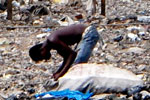
(09/09/2011) In Agbogbloshie, a slum outside the capital city of Accra, Ghana, tons of electronic waste lies smoldering in toxic piles. Children make their way through this dangerous environment, desperate to strip even a few ounces of copper, aluminum, brass, and zinc from worn-out electronics originating from the United States and Europe. “The smell alone will drive all but the most desperate away, but many are so desperate they persevere despite the obvious dangers. It is a very tough thing to witness,” explains Dr. Kwei Quartey, a Ghanaian author and physician, in a recent mongabay.com interview.
Universal phone charger to cut e-waste
(02/18/2009) Mobile phone manufacturers will introduce a universal charger for handsets by 2012, reports CNN.
U.S. ignores laws on e-waste disposal
(09/19/2008) U.S. laws for exporting electronic waste (e-waste) are widely ignored, according to a General Accountability Office (GAO) report, which faults the Environmental Protection Agency.
Sony launches consumer electronics recycling program
(08/17/2007) Sony has launched a recycling program for consumer electronics.
Apple defends green credentials, promises to do better
(05/04/2007) In a open letter posted Wednesday, Apple Inc. CEO Steve Jobs countered claims by green groups that the iPod and computer maker lagged in recycling and removing toxic chemicals from its products. He said the company is already an industry leader when it comes to the environment and that Apple will continue to reduce its impact on the planet.
Consumers want environmentally friendly computers
(06/26/2006) A study conducted earlier this year by Ipsos-MORI on behalf of Greenpeace found that consumers say they would be willing to pay more for an environmentally friendly computer. The amounts ranged from $59 in Germany, $118 in UK, $199 in China and $229 in Mexico.